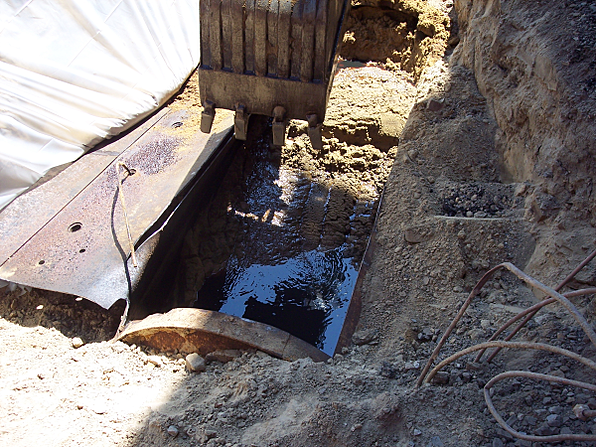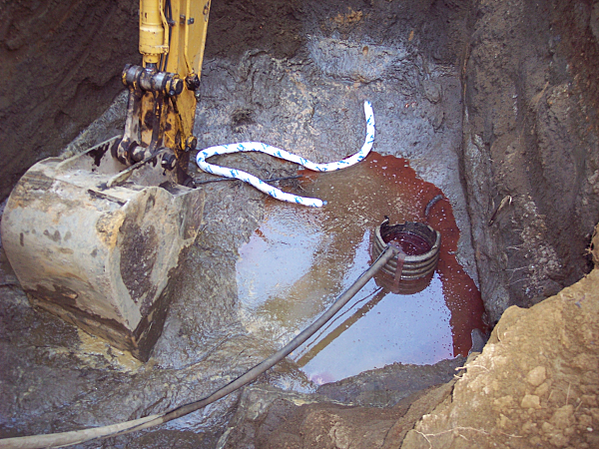As Is real estate with a buried Oil Tank
As the term implies “As Is” real estate means that you are purchasing the property in the current condition the property is in. When purchasing As Is real estate, the seller is not expected to undertake any repairs or improvements. To enter into a as is real estate purchase the buyer must complete their due diligence and evaluate the property for defects and repairs, the cost of which needs to be accounted for in the purchase price. Many properties that are listed for sale as is may already have a reduced market price or at least that maybe the perception of the seller. The price reduction on the asking price typically accounts for the condition of the real estate (structure, HVAC, roof, ect). The problem with As Is real estate is that any price reductions rarely if ever account for environmental costs.
The following photo shows a tank that was "properly closed in place" as per the local construction office. This tank was filled in place with sand and inspected by the local building inspection and received an approval sticker. The new owners of the property decided to remove it after purchase to make way for an addition. They found a tank full of oil and sand, and an expense that was not expected.
Typically due diligence of a property involves two primary areas, one being property condition assessment (on residential sites this is accomplished by a Home Inspection) and environmental assessment (on commercial sites this is completed by performing a Phase I Environmental Site Assessment -ESA). For residential sites, an environmental assessment can consist of inspection and testing for past and present Underground Storage Tanks (USTs), mold inspections & testing, asbestos surveys, radon testing, and well water testing.
Of all these issues, heating oil underground storage tanks create the largest financial environmental liability. Unlike a home inspection which can range between $400.00 and $1,000.00. The cost to determine if a tank is leaking AND when a tank is found to be leaking to determine to what extent the oil has leaked (delineation) can cost in the thousands of dollars. The investigation to evaluate the extent of leaking oil tanks can be compared to a doctor performing diagnostic tests such as x-rays, cat scans, blood work to diagnosis a patents ailments. In both situations a problem exists (health or environmental), which simple cannot be determined by a simple physical evaluation but testing must be performed to define the issue. These testing costs are typically a major hurdle to a buyer.
This photos shows a more serious tank leak where the oil leaked deeper into the water table. The seller would not allow the buyer to do any testing before purchase.

Regulations in New Jersey place the responsibility of the remediation of a leaking oil tank on the property owner. Most buyers mistakenly believe that if they find a tank leaking on a property they are purchasing they are responsible for the cleanup.
Curren’s experience in successful As Is real estate transactions with heating oil Underground Storage Tanks (USTs), is that once a tank is found to be leaking, the cleanup is eventually performed by the seller or a substantial discount is given to the buyer that is in excess of the cost of remediation. This premium reduction is meant to address the management of the remediating the problem as well as the financing of paying for the problem. To actually get to this point in a real estate transaction, thousands of dollars in investigative borings and laboratory analysis is incurred so that the cost of cleanup can be developed. Without this investigative step, the two parties cannot determine the extent of the contamination (diagnosis the problem), hence the problem with As Is real estate, it is costly to determine the future environmental cleanup expense.
Obviously, the As Is real estate sale is to the benefit of the seller as they avoid the management and cost of making repairs to a site. Whereas a Home Inspection report can be used to obtain estimates from various construction trades (these estimates are usually provided at no cost and only require the contractor to visit the site), environmental cleanup to be scientifically accurate must be based on soil sampling that define the vertical and horizontal extent of the contamination. This delineation provides a 3D model of the length, height and width of the area requiring remediation. Unfortunately, environmental professions cannot simple visit a site to determine remediation cost, as the contamination is buried below ground and invisible to the naked eye. Remediation costs can range from several thousand dollars or can be in excess of $100,000.00. What is the difference in the expense? Location of the discharge, the extent of the plume, duration of leak, geology, ect. Simple put bigger areas of contamination are more costly to remediate than smaller areas.
The real estate landscape is littered with lawsuits on property transfers where tanks were not previously disclosed. The new owner finds the tank, discovers contamination and is now saddled with the financial responsibility of the cleanup. Lawsuits typically name prior property owners, insurance companies and parties involved in the real estate transaction. These suits attempt to uncover if the prior owner knew of the tank and concealed or failed to disclose the existence of the tank. Other instances are more complex where the prior owner had also bought the property without knowledge of the tank.
At Curren Environmental, we consult on environmental issues and real estate. If you have a question about environmental issue regarding oil tanks, contact our office for a free no obligation consultation.
